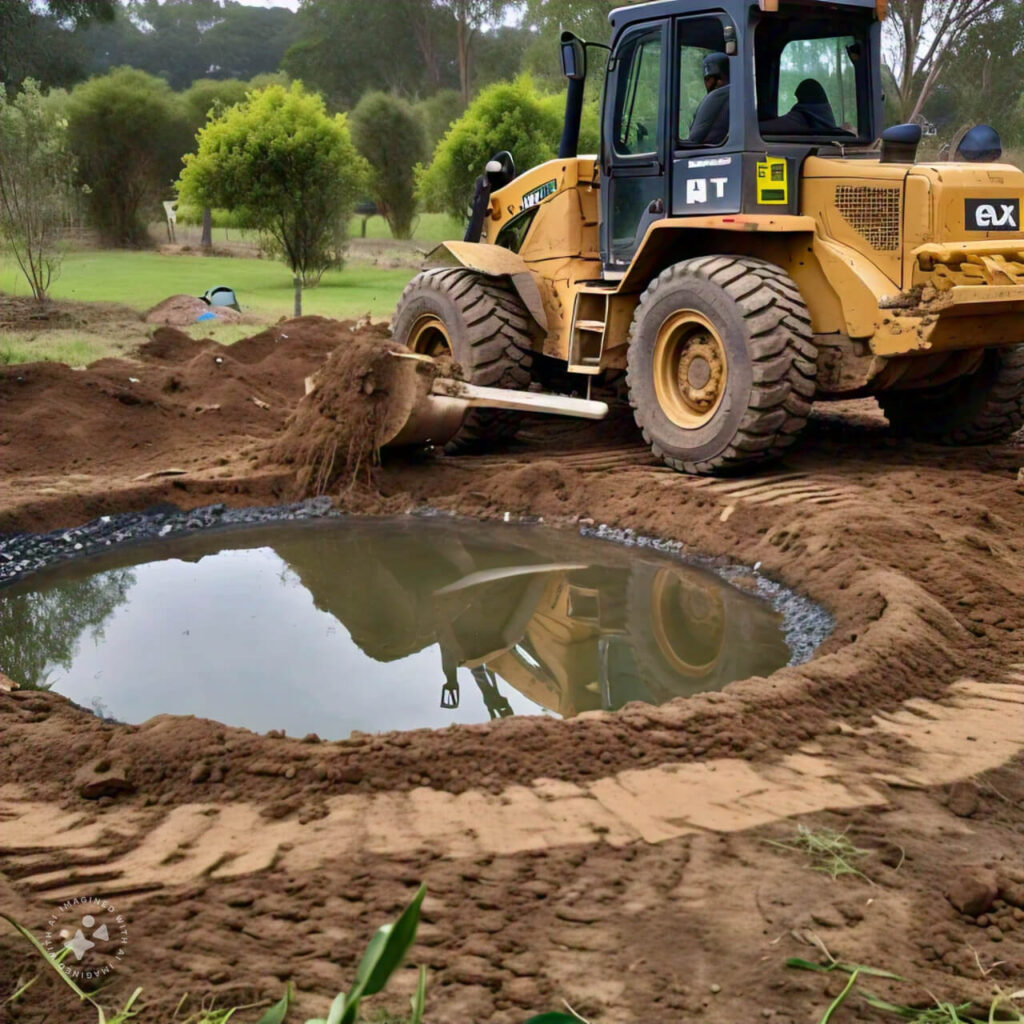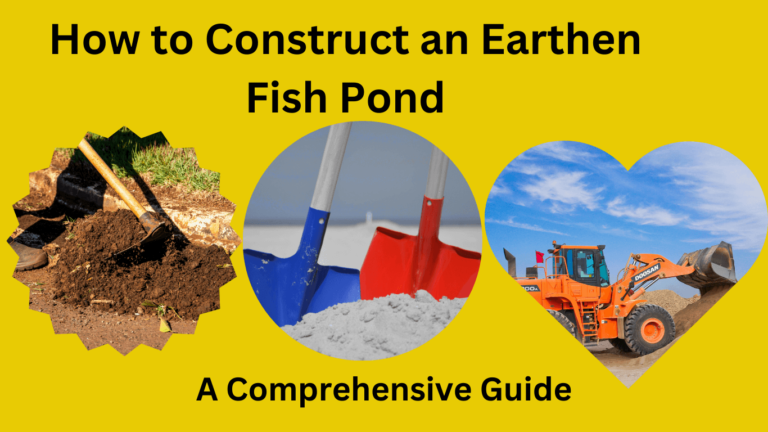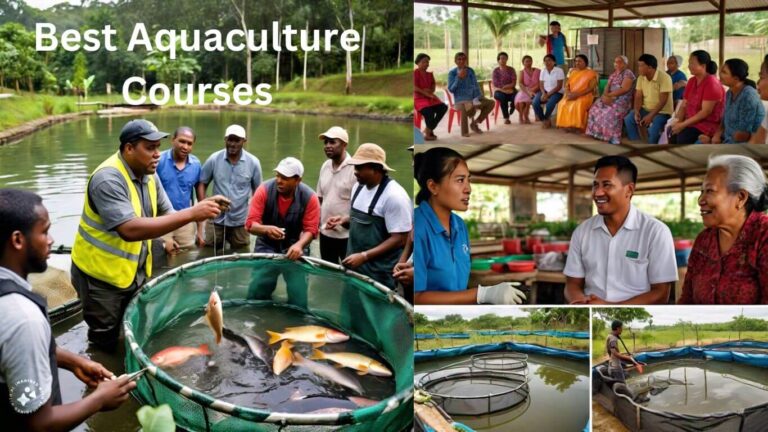How to construct an earthen fish pond is a crucial step for anyone looking to start fish farming.
Earthen ponds are popular due to their natural environment, cost-effectiveness, and suitability for various fish species. You can read more in my post on the earthen fish pond.
This guide will take you through the steps to successfully build an earthen fish pond, including the factors to consider when selecting a site, the materials needed, and the construction process.
1. Factors to Consider When Selecting the Site
The success of learning how to construct an earthen fish pond largely depends on the location you choose. Here are the critical factors to consider:
a. Soil Type
– The soil should be clayey or loamy, as these types have excellent water retention properties. Sandy soils, on the other hand, are not suitable as they allow water to seep through easily.
– A minimum of 20-30% clay content is recommended to prevent leakage.
b. Water Availability
– The site should be close to a reliable water source, such as a river, stream, or borehole.
Consistent water supply is vital for maintaining the pond’s water level, especially during dry seasons.
– Ensure that the water source is clean and free from pollutants, as the quality of water directly affects fish health.
c. Topography
– Choose a site with a gentle slope (1-3%) to facilitate natural water flow and drainage.
– Avoid areas prone to flooding, as excessive water can overflow the pond and wash away fish or damage the embankment.
d. Accessibility
– The pond should be easily accessible for monitoring, feeding, harvesting, and marketing the fish.
– Consider proximity to roads and transportation routes for the easy movement of supplies and harvested fish.
e. Environmental Factors
– Ensure the site has enough sunlight for at least 6-8 hours a day, as sunlight is essential for the growth of phytoplankton, which is a natural food source for fish.
– Avoid areas with high wind exposure, which can cause erosion and damage to the pond structure.
2. Materials Needed for Constructing an Earthen Fish Pond
Before beginning the construction, gather the following materials:
a. Soil
– Clayey or loamy soil for the pond base and embankments.
b. Excavation Equipment
– Spades, shovels, pick axes, and hoes for manual excavation.
– If the pond is large, consider hiring a bulldozer or excavator for efficient digging.
c. Water Inlet and Outlet Pipes
– PVC pipes or concrete pipes for water management.
– Install a screen at the inlet to prevent debris from entering the pond and at the outlet to prevent fish from escaping. This could be wiregods, nets, or anything that can prevent rubbish from entering and fish from escaping.
d. Measuring Tools
– Measuring tape and leveling instruments to ensure accurate dimensions and slope.
e. Lining Material (Optional)
– Some ponds may require additional lining, such as a clay layer or a synthetic liner, or tarpaulin to prevent seepage.
f. Vegetation
– Grass seeds or fast-growing plants to stabilize the embankment and prevent erosion.
g. Water Quality Testing Kit
– Essential for monitoring pH level, dissolved oxygen, and other water quality parameters.
3. Steps to Construct an Earthen Fish Pond
Once you have selected the site and gathered the materials, follow these steps to construct the pond:
a. Site Preparation
– Clear the site of vegetation, rocks, and debris.
– Mark the boundaries of the pond using stakes and ropes based on the desired dimensions.
b. Excavation
– Begin excavating the pond, starting from the center and moving outward.
– Ensure the pond has a uniform depth, with the deepest part in the middle (2-3 meters for most fish species).
– Create a gentle slope from the pond’s edges to the center to facilitate water flow and fish movement.
c. Embankment Construction
– Use the excavated soil to build embankments around the pond’s perimeter.
– Compact the soil thoroughly to prevent erosion and ensure stability.
– The embankment should be 1.5-2 meters wide at the base and 1-1.5 meters high, with a gentle slope on both sides.
d. Inlet and Outlet Installation
– Install the water inlet pipe at the highest point of the pond to allow water to flow in naturally.
– Position the outlet pipe at the lowest point for efficient drainage.
– Ensure both pipes are fitted with screens to control water flow and prevent fish from escaping.
e. Sealing the Pond
– If necessary, line the pond bottom with a layer of compacted clay or a synthetic liner or tarpaulin to prevent seepage.
– In some cases, bentonite clay can be added to the soil to enhance water retention.
f. Planting Vegetation
– Plant grass or other vegetation on the embankments to prevent erosion.
– Consider adding aquatic plants to the pond, which can provide shelter for fish and improve water quality. It can also serve as supplementary feed for the fish.
g. Filling the Pond with Water
– Gradually fill the pond with water, monitoring for any leaks or structural issues.
– Allow the pond to settle for a few days before introducing fish. In that case, if there are any chemicals like chlorine, it will evaporate before you introduce the fish.
4. Pond Management and Maintenance
After constructing the pond, ongoing management is essential to maintain its functionality and ensure the health of the fish:
a. Water Quality Monitoring
– Regularly test the water for pH, dissolved oxygen, ammonia, nitrite, and nitrate levels.
– Take corrective measures if any parameters are out of the optimal range.
b. Erosion Control
– Inspect the embankments regularly for signs of erosion or damage.
– Repair any cracks or weak spots immediately to prevent further deterioration.
c. Vegetation Management
– Control the growth of aquatic plants and algae to prevent overgrowth, which can deplete oxygen levels in the water.
– you have to remove any weeds or invasive species from the pond and its surroundings.
d. Fish Health Monitoring
– You should always monitor the fish for signs of stress, disease, or abnormal behavior.
– Always maintain a proper feeding schedule and ensure that the fish receive a balanced diet.
e. Pest and Predator Control
– Implement measures to protect the pond from predators such as birds, snakes, or rodents.
– Use nets or fencing if necessary to keep the fish safe from predators.

5. Conclusion
Constructing an earthen fish pond requires careful planning, the right materials, and a good understanding of the site’s conditions.
By following the steps outlined in this guide, you can create a sustainable and productive environment for fish farming.
Remember that ongoing maintenance and monitoring are crucial to ensuring the long-term success of your pond.
Whether you’re a beginner or an experienced fish farmer, building a well-constructed earthen pond will lay the foundation for a profitable and efficient fish farming operation.





